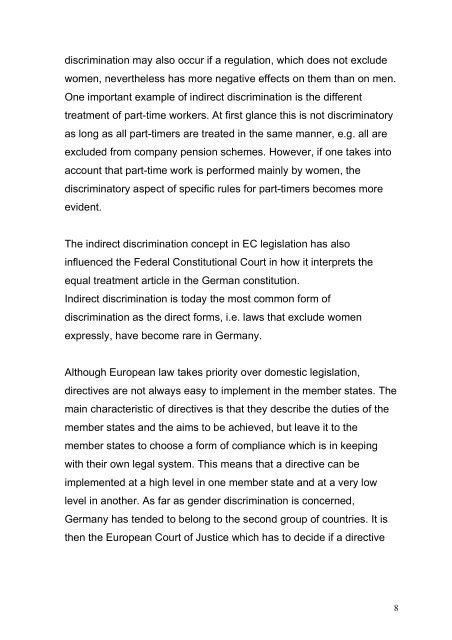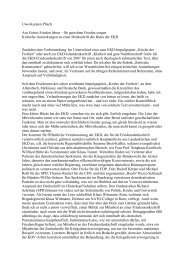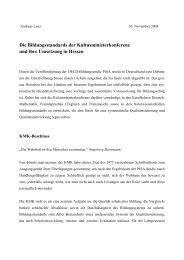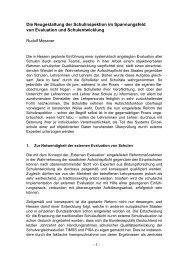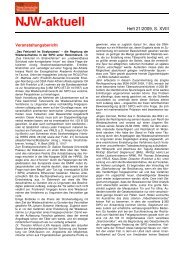Constitutional and Legal Framework of Gender Justice in Germany
Constitutional and Legal Framework of Gender Justice in Germany
Constitutional and Legal Framework of Gender Justice in Germany
You also want an ePaper? Increase the reach of your titles
YUMPU automatically turns print PDFs into web optimized ePapers that Google loves.
discrim<strong>in</strong>ation may also occur if a regulation, which does not exclude<br />
women, nevertheless has more negative effects on them than on men.<br />
One important example <strong>of</strong> <strong>in</strong>direct discrim<strong>in</strong>ation is the different<br />
treatment <strong>of</strong> part-time workers. At first glance this is not discrim<strong>in</strong>atory<br />
as long as all part-timers are treated <strong>in</strong> the same manner, e.g. all are<br />
excluded from company pension schemes. However, if one takes <strong>in</strong>to<br />
account that part-time work is performed ma<strong>in</strong>ly by women, the<br />
discrim<strong>in</strong>atory aspect <strong>of</strong> specific rules for part-timers becomes more<br />
evident.<br />
The <strong>in</strong>direct discrim<strong>in</strong>ation concept <strong>in</strong> EC legislation has also<br />
<strong>in</strong>fluenced the Federal <strong>Constitutional</strong> Court <strong>in</strong> how it <strong>in</strong>terprets the<br />
equal treatment article <strong>in</strong> the German constitution.<br />
Indirect discrim<strong>in</strong>ation is today the most common form <strong>of</strong><br />
discrim<strong>in</strong>ation as the direct forms, i.e. laws that exclude women<br />
expressly, have become rare <strong>in</strong> <strong>Germany</strong>.<br />
Although European law takes priority over domestic legislation,<br />
directives are not always easy to implement <strong>in</strong> the member states. The<br />
ma<strong>in</strong> characteristic <strong>of</strong> directives is that they describe the duties <strong>of</strong> the<br />
member states <strong>and</strong> the aims to be achieved, but leave it to the<br />
member states to choose a form <strong>of</strong> compliance which is <strong>in</strong> keep<strong>in</strong>g<br />
with their own legal system. This means that a directive can be<br />
implemented at a high level <strong>in</strong> one member state <strong>and</strong> at a very low<br />
level <strong>in</strong> another. As far as gender discrim<strong>in</strong>ation is concerned,<br />
<strong>Germany</strong> has tended to belong to the second group <strong>of</strong> countries. It is<br />
then the European Court <strong>of</strong> <strong>Justice</strong> which has to decide if a directive<br />
8


